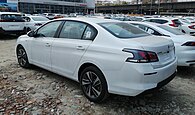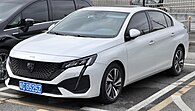Peugeot 408 (saloon)
Motor vehicle From Wikipedia, the free encyclopedia
The Peugeot 408 is a compact car (C-segment) produced by Peugeot since 2010. It was unveiled on January 25, 2010,[1] at the Beijing Auto Show and sales began in China on April 8, 2010.[2] In November 2010, production of the 408 commenced in El Palomar, Buenos Aires, Argentina,[3] with sales starting in April 2011.
| Peugeot 408 | |
|---|---|
 Peugeot 408 II 2022MY | |
| Overview | |
| Manufacturer | Peugeot |
| Production | 2010–present |
| Body and chassis | |
| Class | Compact car (C) |
| Body style | 4-door saloon |
| Layout | Front-engine, front-wheel-drive |
| Related | Peugeot 308 |
| Chronology | |
| Predecessor | Peugeot 307 saloon |
Despite its name, it is not a direct successor to the Peugeot 407, but rather a long-wheelbase saloon version of the Peugeot 308 hatchback,[4] primarily targeted at emerging markets such as China.[5] The 408 is not slated for the Western European market, and not built there.
First generation (T7; 2010)
Summarize
Perspective
| First generation | |
|---|---|
 | |
| Overview | |
| Production | 2010–2021 |
| Assembly | Argentina: El Palomar (PSA Argentina) China: Wuhan (DPCA) Malaysia: Gurun (NAM) Russia: Kaluga (PCMA Rus) |
| Body and chassis | |
| Platform | PSA PF2 platform |
| Related | Peugeot 308 Dongfeng Fengshen L60 |
| Powertrain | |
| Engine | |
| Transmission | 5-speed manual 4-speed automatic 6-speed EAT6 automatic |
| Dimensions | |
| Wheelbase | 2,710 mm (106.7 in) |
| Length | 4,680 mm (184.3 in) |
| Width | 1,815 mm (71.5 in) |
| Height | 1,525 mm (60.0 in) |
| Chronology | |
| Predecessor | Peugeot 307 saloon |
The 408 was available in China with either a 1.6 L and 2.0 L petrol four cylinder engine. The 1.6 (TU5JP4) has a capacity of 1587 cc and produces 85 kW (115 PS; 113 hp) at 5,750 rpm and maximum torque of 147 N⋅m (108 lb⋅ft) at 4,000 rpm. The 2.0 L (EW10A+) engine has a capacity of 1997 cc and produces 110 kW (150 PS; 148 hp) at 6,000 rpm and 200 N⋅m (148 lb⋅ft) at 4,000 rpm.[6]

Either engine can be specified with a five speed manual or four speed automatic transmission.
In South America a 1.6 L diesel engine, known as a HDi (Allure, Feline/Griffe), is sold alongside the 2.0 L petrol engine (Allure, Feline/Griffe) and 1.6L THP petrol engine (Sport) with six speed automatic transmission. The four cylinder diesel has a capacity of 1560 cc and produces 81 kW (110 PS; 109 hp) and torque of 240 N⋅m (177 lb⋅ft).
The HDi has a top speed of 188 km/h (116.8 mph) and accelerates to 100 km/h (62 mph) in 12.4 seconds.[7]
In Malaysia, 408 comes with two engines, the 1.6L Prince turbo engine and 2.0L petrol four cylinder engine. The 1.6L engine produces 123 kW (167 PS; 165 hp) at 6,000 rpm. and maximum torque of 240 N⋅m (177 lb⋅ft) from 1,400 rpm.
The 2.0 L (EW10A+) engine has a capacity of 1997 cc and produces 145 bhp (108 kW; 147 PS) at 6,000 rpm and 200 N⋅m (148 lb⋅ft) at 4,000 rpm. The 1.6L turbo engine comes mated with a six-speed manual, while the 2.0L engine is fitted with a four-speed automatic adaptive gearbox with Tiptronic and Sport mode only.

The first generation 408 continued in production in Latin America and Russia, with multiple facelifts and minor changes. Production in Argentina was halted in 2021.[8]
Second generation (T9; 2014)
Summarize
Perspective
| Second generation | |
|---|---|
 2022 Peugeot 408 II (China) (2022 facelift) | |
| Overview | |
| Also called | Dongfeng Fukang ES600 (electric)[9] |
| Production | 2014–present 2016–2018 (Malaysia) |
| Assembly | China: Wuhan (DPCA) Malaysia: Gurun (NAM) |
| Body and chassis | |
| Body style | 4-door saloon |
| Platform | PSA EMP2 platform |
| Related | Peugeot 308 |
| Powertrain | |
| Engine |
|
| Transmission | 6-speed automatic |
| Dimensions | |
| Wheelbase | 2,730 mm (107.5 in) |
| Length | 4,750 mm (187.0 in) |
| Width | 1,820 mm (71.7 in) |
| Height | 1,488 mm (58.6 in) |
| Curb weight | 1,420 kg (3,130.6 lb) 1,373 kg, 1,402 kg (2022 facelift) |
| Chronology | |
| Predecessor | Peugeot 308 saloon |
The second generation Peugeot 408 was unveiled in the 2014 Beijing Auto Show. In June 2016, the international version of the Peugeot 408 (known as Peugeot 408 e-THP) was launched in Malaysia, though with only one engine choice and transmission. The second generation 408 launched in China is powered by a range of engine options including a 1.8-litre engine producing 139 hp, a 1.2-litre turbo engine with 136 hp, and 1.6-litre turbo engine with 167 hp. All engines are mated with a 6-speed automatic transmission, with a 6-speed manual transmission option also available for the 1.8-litre and 1.2-litre engines.[10]
- Peugeot 408 II (China) pre-facelift (front)
- Peugeot 408 II (China) pre-facelift (rear)
2018 facelift
A facelift was launched in 2018, featuring a redesigned front fascia, rear bumper, and tail lamps. Powertrain is carried over from the pre-facelift model.[10]
- Peugeot 408 II facelift (front)
- Peugeot 408 II facelift (rear)
2022 facelift
A second facelift for the 408 was revealed for the Chinese market on 8 June 2022. The front end is redesigned to reflect the same design language as the third-generation Peugeot 308.[11] The bootlid is redesigned, featuring new graphics and taillights similar to the third-generation 308.
All trim levels are equipped with a model 5G06 1.6L turbo engine producing 125kW at 5500 rpm and 250Nm at 1750-4500 rpm, and an Aisin 3rd generation 6AT transmission.[12]
In march 2024 the new 1.5 THP 360 engine was introduced producing 127kW at 5500 rpm and 255 Nm at 1750-4500 rpm.[13][14]
- Peugeot 408 II second facelift (front)
- Peugeot 408 II second facelift (rear)
Dongfeng Fukang ES600
The Dongfeng Fukang ES600 is an electric sedan based on the 2014–2018 pre-facelift Peugeot 408, launched under Dongfeng Peugeot-Citroën's Fukang brand.[15]

Sales
| Year | Brazil[16] |
|---|---|
| 2011 | 6,564 |
| 2012 | 7,711 |
| 2013 | 4,618 |
| 2014 | 3,332 |
| 2015 | 1,427 |
| 2016 | 927 |
| 2017 | 1,118 |
| 2018 | 739 |
| 2019 | 122 |
| 2020 | 2 |
References
External links
Wikiwand - on
Seamless Wikipedia browsing. On steroids.






